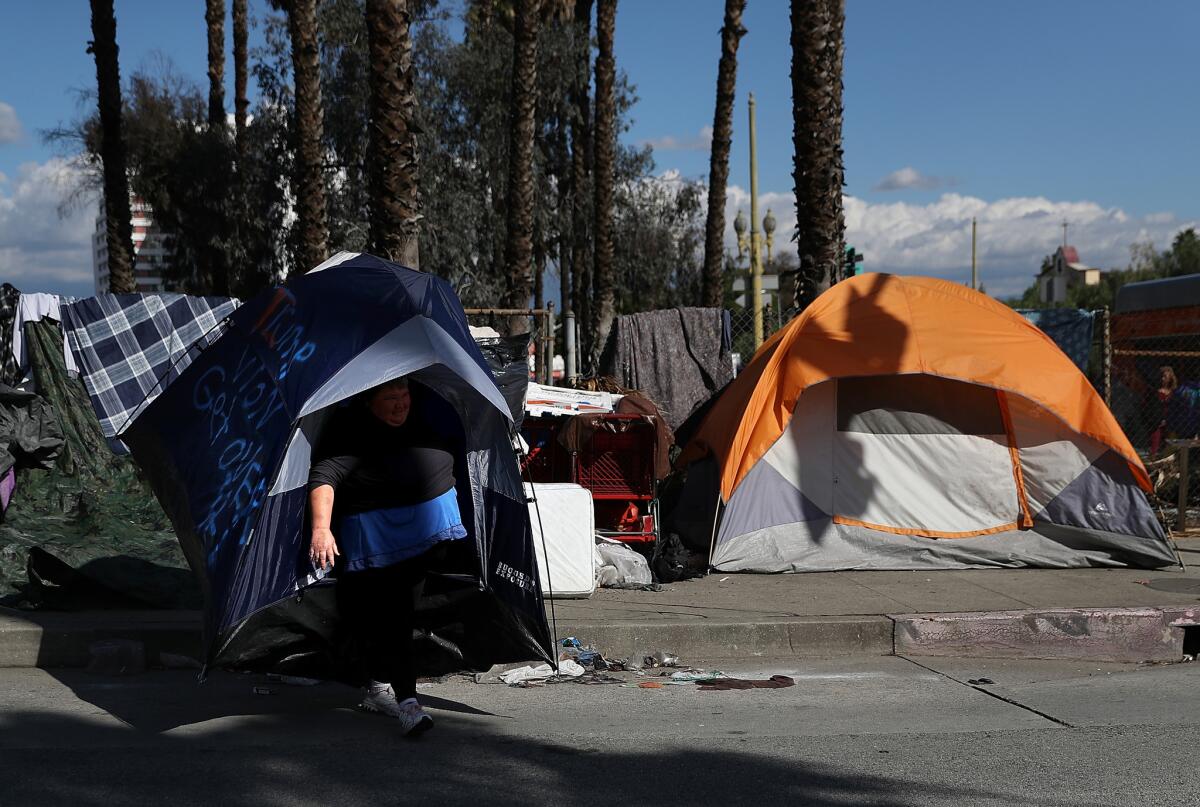County voters to decide on quarter-cent sales tax for homelessness programs

- Share via
When Los Angeles voters overwhelmingly approved a bond measure in November to build apartments for the chronically homeless, long-frustrated advocates hailed the victory as a watershed in their efforts to provide permanent homes for thousands of people living on the city’s sidewalks and parkland.
But despite enthusiasm that couldn’t always be contained, proponents of Proposition HHH were mostly careful not to call it the ticket to ending homelessness. Rather, it was a down payment.
Now, voters across Los Angeles County are being asked to approve the balance — a quarter-cent sales tax to support a broad canvas of strategies. They include services for those living in thousands of new housing units, rental subsidies for thousands more across the county, hundreds of new outreach workers and short-term interventions to help those in crisis keep their homes.
Measure H on the March 7 ballot would produce a projected $3.55 billion for homeless programs over 10 years. The tax increase would raise the sales tax rate to 9% across most of Los Angeles County and up to 10% in a few communities. Because it would increase taxes, it requires a two-thirds majority to pass.
Like Proposition HHH, Measure H is supported by a coalition of elected officials, nonprofit organizations, labor unions, business groups and philanthropists. Backers say it finally would fill the gap in resources that has prevented local agencies from arresting the spread of tent encampments and RV villages from the Palisades to Pomona.
Phil Ansell, head of the county’s Homeless Initiative, said enactment of the measure would move an estimated 45,000 families and individuals from homelessness into permanent housing during the first five years, while preventing 30,000 more families and individuals from becoming homeless during the same period.
“Measure H revenue will enable the most comprehensive plan to combat homelessness in the history of Los Angeles County,” Ansell said.
A campaign fund that has topped $2 million will be spent primarily on motivating voters in cities and unincorporated areas where Measure H will be the only item on the ballot or listed with municipal or school board races, campaign manager Steve Barkan of SG&A Campaigns said.
No group has raised money to campaign against Measure H, and no opposing arguments have been filed with the Los Angeles County Registrar of Voters to be included in sample ballots being mailed to registered voters.
In launching the Measure H campaign on Jan. 30, backers emphasized the services of case managers, mental health clinicians and vocational and addiction counselors who will be needed to help those placed in the new housing units being constructed with city funds.
“We know we can’t simply dangle keys in front of people who are homeless and assume their homelessness will end,” said Joel John Roberts, executive director of PATH, a homeless services agency. “They need intensive services that help them back to a healthy and self-sustaining life.”
But those services would account for only a fraction of the new money — about $245 million in the first five years, according to the Los Angeles County Homeless Initiative and the Los Angeles Homeless Services Authority.
The money would pay for case managers, clinical workers and job and addiction counselors for chronically homeless people who are provided housing under the “housing first” model that starts with a roof over their heads and then addresses individual issues that keep them from living independently.
Measure H revenue will enable the most comprehensive plan to combat homelessness in the history of Los Angeles County.
— Phil Ansell, head of the county’s Homeless Initiative
The complex and still-evolving plan also includes rent to house thousands in existing apartments, shelters and temporary housing for people waiting for permanent homes and assistance programs after leaving jails and hospitals, as well as employment services.
Some of the programs already are operating, funded by the $100-million short-term homelessness fund the Board of Supervisors created last year. A progress report on the county’s homeless strategies was released Thursday.
County officials have outlined the basic strategies that will be funded, but they have not yet issued a budget showing the proportions each will receive. Those decisions will be sorted out by a panel of 50 people appointed from county government, cities and the nonprofit world, Ansell said. Its recommendation will go to the Board of Supervisors on June 13, just about the time the tax revenue would start to flow.
The panel will consider six main categories, subsidized housing, coordinated outreach and shelters, case management and services, homelessness prevention, income support and preservation of existing housing.
County officials in each of the departments that would provide the services are now working out budget requests for Measure H funds.
A framework for the big-ticket items is contained in the Homeless Authority’s 2016 study analyzing gaps in various forms of housing and shelter and estimating the cost to fill them. That analysis suggests that the largest portion of Measure H funds — as much as $1 billion over the 10 years — would go to shelters and rental housing.
That’s in addition to the 10,000 units to be funded by the city bond. The Housing Authority analysis projects the need for nearly 15,000 new permanent supportive housing units. Most of the difference would be provided by leasing apartments on the open market.
The analysis projects a need for rental subsidies of about $557 million over the first five years and then $186 million each succeeding year. That won’t all come from Measure H.
About 2,000 federal rental subsidies will be thrown into the mix each year by the county’s 18 housing authorities. By 2018, the county also will start receiving installments on the $615 million it anticipates receiving from the state No Place Like Home Act to provide housing for the mentally ill.
In addition to the permanent housing, $360 million is projected over the first five years for what is called rapid rehousing — primarily rental assistance to provide short-term housing for those who have lost their homes or are likely to because of a financial crisis, but don’t require extensive services when they get back on their feet.
ALSO
Fire in Disneyland parking structure burns 8 cars, injures 7 people and prompts evacuations
At a newspaper in Boyle Heights, teenagers learn about their community — and themselves
Secret witness to testify for the prosecution in Durst murder case
Compton Community College regains local control after years of oversight
More to Read
Sign up for Essential California
The most important California stories and recommendations in your inbox every morning.
You may occasionally receive promotional content from the Los Angeles Times.











